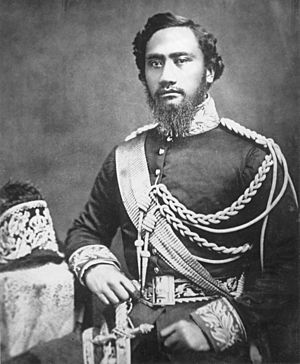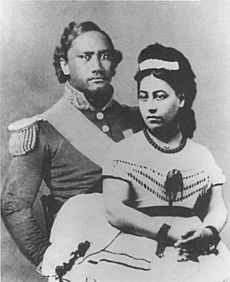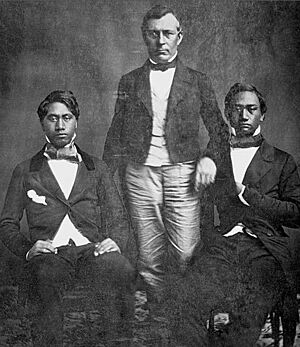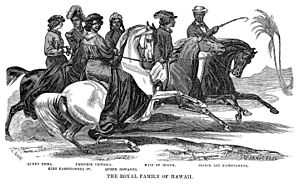Kamehameha IV facts for kids
Quick facts for kids Kamehameha IV |
|||||
|---|---|---|---|---|---|
 |
|||||
| King of the Hawaiian Islands (more...) | |||||
| Reign | January 11, 1855 – November 30, 1863 | ||||
| Investiture | January 11, 1855 Kawaiahaʻo Church |
||||
| Predecessor | Kamehameha III | ||||
| Successor | Kamehameha V | ||||
| Kuhina Nui | Keoni Ana Kaʻahumanu IV |
||||
| Born | February 9, 1834 Honolulu, Oʻahu |
||||
| Died | November 30, 1863 (aged 29) Honolulu, Oʻahu |
||||
| Burial | February 3, 1864 Mauna ʻAla Royal Mausoleum |
||||
| Spouse | Emma | ||||
| Issue | Albert Edward Kauikeaouli | ||||
|
|||||
| House | House of Kamehameha | ||||
| Father | Kekūanāoʻa Kamehameha III (hānai) |
||||
| Mother | Kīnaʻu Kalama (hānai) |
||||
| Religion | Church of Hawaii | ||||
| Signature | |||||
Kamehameha IV (born Alekanetero ʻIolani Kalanikualiholiho Maka o ʻIouli Kūnuiākea o Kūkāʻilimoku), also known as Alexander Liholiho, was the fourth king of the Kingdom of Hawaii. He ruled from January 11, 1855, until his death on November 30, 1863. He became king when he was only 20 years old.
Contents
Early Life and Royal Upbringing
Alexander was born on February 9, 1834, in Honolulu, on the island of Oʻahu. His father was High Chief Mataio Kekūanāoʻa, who was the Royal Governor of Oʻahu. His mother was Princess Elizabeth Kīnaʻu, who served as the Kuhina Nui (a powerful position similar to a Prime Minister) of the Kingdom.
Alexander was the grandson of Kamehameha I, the first king to unite all the Hawaiian Islands. He had three older brothers and a younger sister. When he was a toddler, his uncle, King Kamehameha III, adopted him. The King declared Alexander as his heir, meaning Alexander would be the next in line for the throne. His name 'Iolani means "hawk of heaven" or "royal hawk."
Education and World Travel
Alexander Liholiho attended the Chiefs' Children's School in Honolulu. This school was run by American missionaries, Amos and Juliette Cooke. When he first arrived, he had many attendants, but they were sent home so he could learn to be independent. Alexander enjoyed playing the flute and piano. He also liked singing, acting, and playing cricket.
At age 14, he left the Royal School to study law. When he was 15, he went on an important government trip. He traveled to England, the United States, and Panama. Alexander kept a journal of his experiences during this journey.
This trip was planned after a French attack on Honolulu in 1849. The Hawaiian King, Kamehameha III, wanted to negotiate a treaty with France. He hoped this treaty would protect the islands from future attacks. The King's advisors believed that Alexander and his brother, Lot Kapuāiwa, would learn a lot from this diplomatic mission.
With their guardian, Dr. Judd, Alexander and Lot sailed to San Francisco in September 1849. They then traveled through Panama, Jamaica, New York City, and Washington, D.C.. They also toured Europe and met with leaders like Napoleon III of France and Prince Albert of England. They spoke both French and English, which helped them connect with European society.
The princes and Dr. Judd returned to the United States for a longer visit. In Washington, D.C., they met President Zachary Taylor and Vice President Millard Fillmore. During their travels in the United States, Alexander and Lot experienced some unfair treatment because of their race. These experiences made them feel less trusting of American influence.
Becoming King of Hawaii
After his world travels, Alexander was appointed to the Privy Council and the House of Nobles in 1852. This gave him valuable experience in government. He also learned foreign languages and European customs.
He became the Lieutenant General and Commander in Chief of the Hawaiian military. He worked to improve the army and maintain the old forts. He appointed many officers, including his brother Lot Kapuāiwa. He also worked with Robert Crichton Wyllie, who wanted to create a strong Hawaiian army to protect the islands.
King Kamehameha III passed away on December 15, 1854. On January 11, 1855, Alexander became King Kamehameha IV. He was only 20 years old. His first major decision as king was to stop talks about Hawaii becoming part of the United States.
His main advisors included Robert Crichton Wyllie (foreign affairs), Keoni Ana (interior), Elisha Hunt Allen (finance), and Richard Armstrong (education).

A year after becoming king, Alexander married Emma Rooke. They had known each other since childhood at the Chiefs' Children's School. Queen Emma was the granddaughter of John Young, a British advisor to Kamehameha the Great. She was also Kamehameha the Great's great-grandniece. Their marriage was a happy one, as they both loved opera, literature, and theater.
On May 20, 1858, the royal couple had their only child, Prince Albert Edward Kauikeaouli Kaleiopapa a Kamehameha. Queen Victoria of the United Kingdom of Great Britain and Ireland became Prince Albert's godmother. Sadly, the young prince died at the age of four on August 27, 1862. The exact cause of his death is not known, but it deeply affected his parents.
In 1860, Wyllie hosted a grand costume ball. Even the Catholic bishop attended, dressed as a bishop. Kamehameha IV's father wore a Scottish kilt. The event had German music and French food. Queen Emma dressed as the earth goddess Cybele. Some conservative American missionaries did not approve of the dancing and festivities.
In August 1861, King Kamehameha IV declared that Hawaii would remain neutral in the American Civil War.
Protecting Hawaiian Independence
When Alexander became king, the number of Americans in Hawaii was growing. They had increasing economic and political power. Sugar producers, especially, wanted Hawaii to join the United States. This would allow them to trade freely without taxes. King Alexander worried that the United States might try to take over Hawaii. He strongly believed that joining the U.S. would mean the end of the Hawaiian monarchy and the Hawaiian people's way of life.
Instead of annexation, King Liholiho wanted a trade agreement with the United States. This agreement would involve fair trade and taxes between the two nations. However, sugar plantation owners in the southern United States opposed this treaty. They worried that competition from Hawaii would hurt their businesses.
To reduce Hawaii's reliance on American trade, Alexander tried to make deals with the British and other European governments. He wanted to balance the foreign influences in Hawaii. However, his reign ended before he could complete these plans.
In 1862, as a way to make amends for a past incident, King Kamehameha IV translated the Book of Common Prayer into the Hawaiian language.
Royal Legacy and Contributions
King Alexander and Queen Emma worked hard to improve healthcare and education for their people. They were concerned that foreign illnesses, like leprosy and influenza, were harming the native Hawaiian population. In 1855, Alexander asked the legislature to support a plan for public hospitals and homes for the elderly.
However, the legislature, which had more power under the Constitution of 1852, rejected his healthcare plan. In response, Alexander and Queen Emma raised money from local business people and wealthy residents. Their fundraising was very successful, and they built The Queen's Medical Center. They also raised money for a leprosy treatment center on the island of Maui.
In 1856, Kamehameha IV declared December 25 as the kingdom's national day of Thanksgiving. This was influenced by conservative American missionaries who did not celebrate Christmas. Six years later, he changed his mind and officially made Christmas a national holiday in Hawaii.
During his eight-year reign, the Kingdom of Hawaii added several new territories. These included Laysan Island (1857), Lisianski Island (1857), and Palmyra Atoll (1862). Some people from Sikaiana, near the Solomon Islands, believe their island was also added to Hawaii in 1856.
End of Reign and Lasting Impact
King Alexander died from chronic asthma on November 30, 1863. He was only 29 years old. His brother, Lot Kapuāiwa, became the next king, taking the name Kamehameha V. At King Alexander's funeral, hundreds of children and teachers walked in a procession to say goodbye. He was buried with his son at the Royal Mausoleum of Hawaii on February 3, 1864.
Queen Emma continued to be active in Hawaiian politics after her husband's death. Later, when the Kamehameha dynasty ended, Queen Emma ran to become the ruling monarch but lost to David Kalākaua.
The Feast of the Holy Sovereigns is celebrated every year on November 28 by the Episcopal Church in Hawaii. This day honors King Kamehameha IV and Queen Emma for their contributions to the Hawaiian people.
Images for kids
See also
 In Spanish: Kamehameha IV para niños
In Spanish: Kamehameha IV para niños






